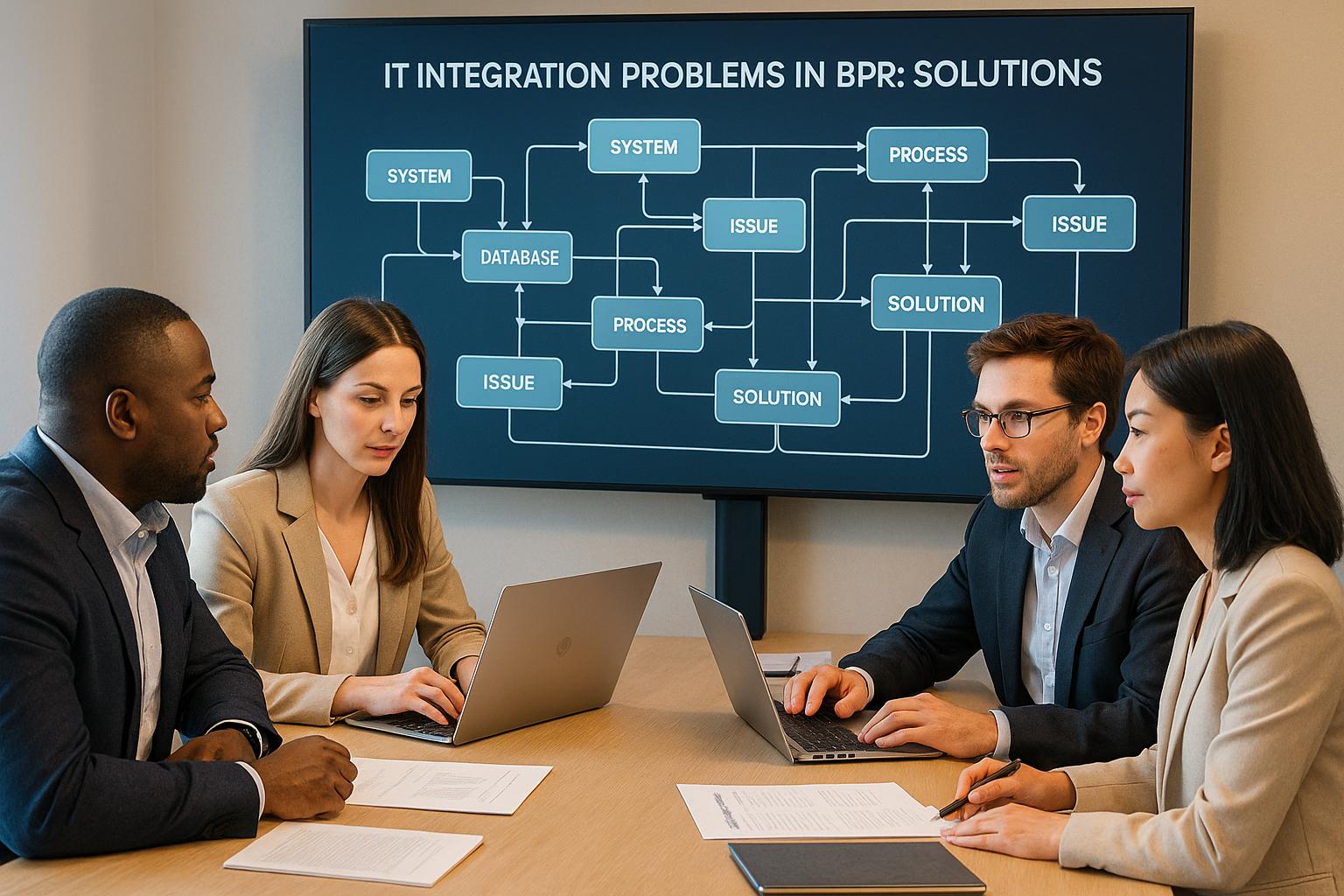Leaders today face a unique challenge: managing resistance to digital transformation. Unlike past changes that involved incremental shifts, digital transformation requires organizations to overhaul core operations, adopt new technologies, and address employee fears about job security and skill relevance. Here's how leadership strategies differ between managing conventional changes and navigating digital transformation:
- Conventional Change: Focuses on adjustments like restructuring or policy updates. Leaders often rely on hierarchical or participative styles, addressing resistance through structured communication, phased rollouts, and training.
- Digital Transformation: Demands faster action, transparent communication, and continuous learning to address fears tied to automation and technology.
Key Takeaway: Effective leadership depends on aligning strategies with the type of change - balancing stability for predictable shifts and agility for digital evolution. A hybrid approach often works best, combining the strengths of both methods.
Resistance as a Resource in Digital Change Management
1. Leadership in Traditional Change Initiatives
Traditional change management has long been guided by well-established frameworks and familiar resistance patterns. Leaders often navigated changes like organizational restructuring, policy updates, process adjustments, or departmental mergers - significant shifts, yet ones that stayed within the conventional boundaries of business operations.
Leadership Styles
In the past, a command-and-control leadership style was the go-to approach. Changes were directed from the top down, with employees expected to adapt within set timelines. This method worked particularly well in hierarchical organizations where authority structures were clear and the changes were relatively straightforward to implement.
Over time, leaders began to recognize the limits of this rigid approach, especially for more complex transitions. Many adopted participative leadership, which involved employees in planning and execution. By gathering feedback and incorporating insights from the ground level, leaders could adjust strategies in real time. This style proved especially effective during mergers and acquisitions, where integrating different organizational cultures benefited from input across various teams.
Transformational leadership also became a key approach in large-scale change efforts. These leaders inspired employees with a compelling vision of the future, emphasizing how the changes would not only strengthen the organization but also advance individual career growth. They excelled at rallying support by building coalitions of "change champions" across all levels of the organization.
Sources of Resistance
Resistance to change in traditional initiatives often arose from predictable concerns. Job security was a major worry, particularly during restructuring, as employees feared losing familiar roles, established reporting lines, or their overall sense of stability.
Poor communication often amplified these fears. When employees were left out of decision-making or provided with vague explanations, they sometimes assumed the worst about leadership’s intentions.
Another common source of resistance was anxiety over skill gaps. New processes often required employees to develop new competencies, and this shift could be intimidating. In traditional settings, these concerns were usually addressed through structured training programs that built on employees' existing skills.
Cultural misalignment was another significant hurdle, especially during mergers or when changes clashed with long-standing organizational values. Employees with long tenures often struggled the most, as they were deeply attached to "the way things have always been done."
Intervention Strategies
To navigate these challenges, leaders relied on several proven strategies. Stakeholder mapping and engagement were crucial; identifying key influencers and securing their support early on helped smooth the path for broader initiatives. Phased implementation allowed changes to be tested on a smaller scale first, helping to identify and address potential issues before rolling them out organization-wide.
Training and development programs played a key role in bridging skill gaps, offering employees structured learning opportunities that built on their existing knowledge. Communication campaigns were equally important. Regular updates through town halls, newsletters, and team meetings helped build trust, address concerns, and ensure employees felt informed throughout the process. These tactics often worked particularly well in smaller teams or departments.
Outcomes
When leaders followed established methodologies, traditional change initiatives often delivered measurable results. Success was reflected in metrics like employee satisfaction, productivity, and financial performance, all of which demonstrated the impact of the changes.
Resistance, while common, tended to diminish over time with clear communication and adequate support. In many cases, organizations achieved full adoption of changes, though the timeline varied depending on the complexity of the initiative.
Leaders who successfully managed these initiatives often enhanced their credibility. A track record of effective restructuring, policy updates, or process improvements positioned them as skilled change agents, opening doors to future leadership opportunities.
However, these traditional methods weren’t without their limitations. Command-and-control approaches, for instance, sometimes led to surface-level compliance rather than genuine engagement. On the other hand, participative methods, while inclusive, could slow down implementation to an impractical degree. While effective for routine changes, traditional approaches often struggled to meet the demands of more complex transformations, such as those required in the digital age. This contrast underscores the need for more agile leadership in navigating today’s rapidly evolving business landscapes.
2. Leadership in Digital Transformation
Leading a digital transformation is no small feat - it reshapes how organizations operate and communicate at every level. This evolution demands a new kind of leadership, one that goes beyond the traditional playbook.
Active Leadership Engagement
In the digital age, leaders can't just sit on the sidelines. They need to be visible, set clear digital goals, and actively model the practices they want their teams to adopt. Unlike traditional changes, which often follow a step-by-step approach, digital transformation calls for swift, decisive action to tackle resistance that’s often tied to new technologies.
Clear and Transparent Communication
Communication becomes a cornerstone during digital transformation. Leaders must articulate not only what is changing but also why these changes matter. Messaging should be consistent, transparent, and tailored to address employee concerns - especially those around digital tools and automation. The goal? To ease fears and highlight both the immediate and long-term benefits of the transformation.
Ongoing Learning and Development
Adapting to digital tools requires more than a one-time training session. Organizations need robust learning programs that include workshops, on-demand resources, and continuous support. These efforts should go beyond basic skill-building, helping employees truly understand and master the complexities of digital technologies.
For those looking for expert guidance, the Top Consulting Firms Directory offers a curated list of firms specializing in leadership strategies for digital transformation.
sbb-itb-97f6a47
Advantages and Disadvantages
When it comes to leading change, traditional change leadership and digital transformation leadership each come with their own set of strengths and challenges.
Traditional change leadership relies on time-tested methods that have been refined over decades. Leaders using this approach benefit from established frameworks and predictable timelines, which make resource planning and expectation management more straightforward. The step-by-step nature of this method helps secure stakeholder support at every stage.
But there’s a downside: this approach can be painfully slow - especially in today’s fast-moving business world. The rigid structure often hampers creativity and innovation, and bureaucratic hurdles can stall crucial decisions at the worst possible moments.
On the other hand, digital transformation leadership thrives in environments where speed and adaptability are essential. It encourages rapid change, promotes ongoing learning, and builds workforces that can pivot quickly. Technology plays a central role, enabling leaders to communicate more effectively with employees and monitor progress in real time.
However, digital transformation isn’t without its challenges. It demands significant resources and adds layers of complexity. Leaders must not only navigate new technologies but also address employee concerns about job security and outdated skills. The relentless pace of change can lead to burnout - for both leaders and their teams. The table below highlights the key differences between these two approaches:
| Aspect | Traditional Change | Digital Transformation |
|---|---|---|
| Leadership Style | Hierarchical, methodical | Collaborative, agile |
| Primary Resistance Sources | Process changes, role adjustments | Technology fears, skill gaps |
| Key Strategies | Structured communication, phased rollouts | Continuous learning, transparent messaging |
| Timeline | Months to years | Weeks to months |
| Resource Investment | Moderate and predictable | High and variable |
| Success Outcomes | Stable, incremental improvements | Swift innovation and competitive edge |
The choice between these approaches often depends on factors like how digitally advanced the organization is and the level of market pressure it faces. Industries experiencing rapid disruption are better suited to digital transformation leadership, while more stable sectors can stick with traditional methods.
For many organizations, a hybrid approach offers the best of both worlds. This strategy combines the steady foundation of traditional methods with the agility of digital practices, allowing businesses to embrace necessary technological advancements without losing their footing.
Conclusion
Comparing traditional change leadership with digital transformation leadership highlights how each approach serves distinct organizational needs. The key to success lies in aligning the strategy with the specific context of the organization.
In environments where stability prevails, traditional methods shine. These approaches, rooted in methodical planning and predictable outcomes, are ideal for organizations that can afford longer timelines and aren't under immediate pressure to innovate. However, they often fall short when rapid action or groundbreaking innovation is required.
On the other hand, digital transformation leadership offers the agility that modern businesses increasingly demand. Its collaborative, technology-focused approach enables companies to remain competitive in fast-paced markets. That said, it comes with challenges, such as the need for significant investments in technology and workforce upskilling.
Resistance to change also differs between these two approaches. Traditional change efforts often encounter pushback related to process shifts and role adjustments. In contrast, digital transformation faces deeper resistance tied to concerns about technological proficiency and job security. Recognizing these differences allows leaders to develop more tailored strategies to address resistance effectively.
A hybrid approach can provide a balanced solution. By combining the reliability of traditional methods with the agility of digital strategies, organizations can adapt to a variety of challenges. Stable, long-term changes may benefit from traditional techniques, while innovation-driven, time-sensitive initiatives might require the speed and flexibility of digital transformation methods.
For organizations seeking additional expertise, the Top Consulting Firms Directory offers access to professionals specializing in digital transformation and organizational change. These experts can provide customized solutions to address leadership challenges.
Ultimately, successful change leadership is about knowing when to use each approach, how to integrate them, and how to address resistance effectively. Leaders who master both traditional and digital transformation strategies will be better equipped to guide their organizations through the complexities of change.
FAQs
What can leaders do to effectively manage resistance during digital transformation while leveraging traditional change management techniques?
Leaders tackling resistance during digital transformation need a mix of time-tested change management techniques and a forward-looking mindset. Unlike other change initiatives, digital transformation often brings swift technological advancements and innovation, which can amplify pushback. To navigate this, leaders should prioritize open and clear communication, highlighting the advantages of the transformation while actively involving employees in the journey.
Setting measurable goals, leading by example, and nurturing a culture that embraces change can go a long way in building trust and easing uncertainty. Encouraging employee feedback and fostering collaboration makes individuals feel valued and connected to the transformation's goals. This approach not only addresses technical challenges but also creates emotional investment, paving the way for meaningful and lasting change.
How can leaders help employees feel secure and confident about their roles during digital transformation?
Leaders play a key role in helping employees navigate the challenges of digital transformation. By encouraging open communication and building trust, they can ease anxieties and create a sense of stability. It's important for leaders to clearly explain why these changes are happening, outline the potential for growth, and address any concerns about job security openly and honestly.
Offering training programs and resources is another critical step. When employees have the tools to develop new skills, they feel more prepared to adapt to the evolving workplace. Leaders can further show their commitment by actively listening to feedback, involving employees in decision-making, and setting an example through their own actions. These efforts not only reduce resistance but also inspire teams to approach the transformation with confidence and a sense of shared purpose.
How should leadership approaches evolve to address resistance during digital transformation compared to traditional change efforts?
Leadership during digital transformation calls for moving away from old-school, top-down management styles and embracing a more collaborative and inclusive approach. It’s about creating an environment where open communication thrives, trust is nurtured, and employees feel like active participants in the journey. This not only minimizes resistance but also helps secure their full support.
Unlike traditional change initiatives, digital transformation comes with fast-paced technological shifts and a lot of uncertainty. To navigate this, leaders must focus on continuous learning, offer opportunities for employees to develop new skills, and cultivate a workplace culture that values innovation and adaptability. Showing empathy for concerns and staying visibly committed to the shared vision can help leadership steer their teams through the challenges of digital transformation with confidence and clarity.


